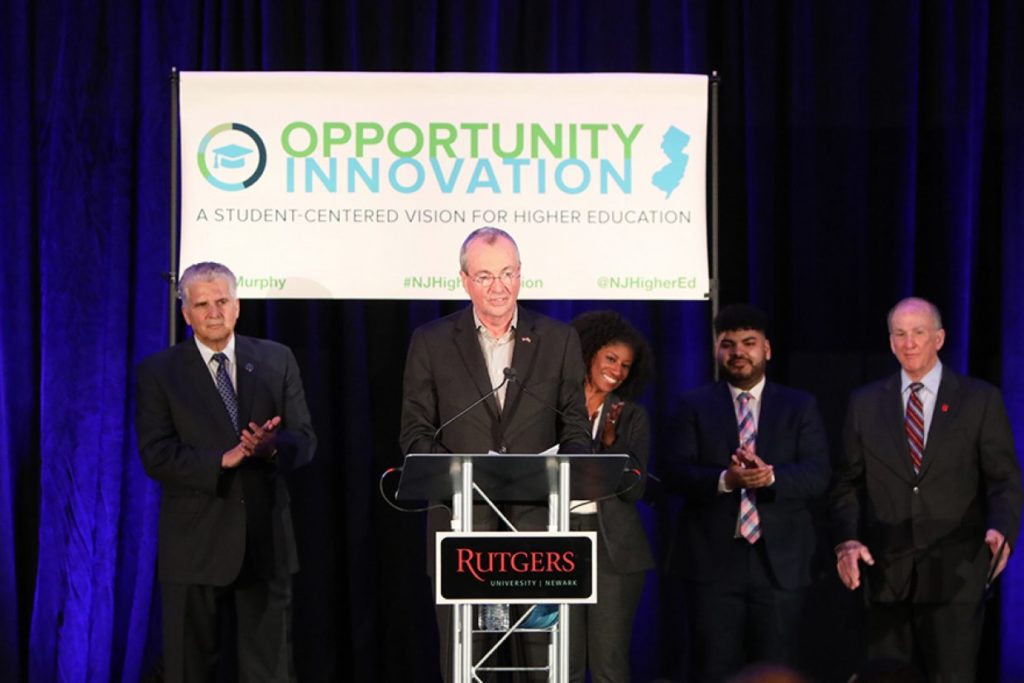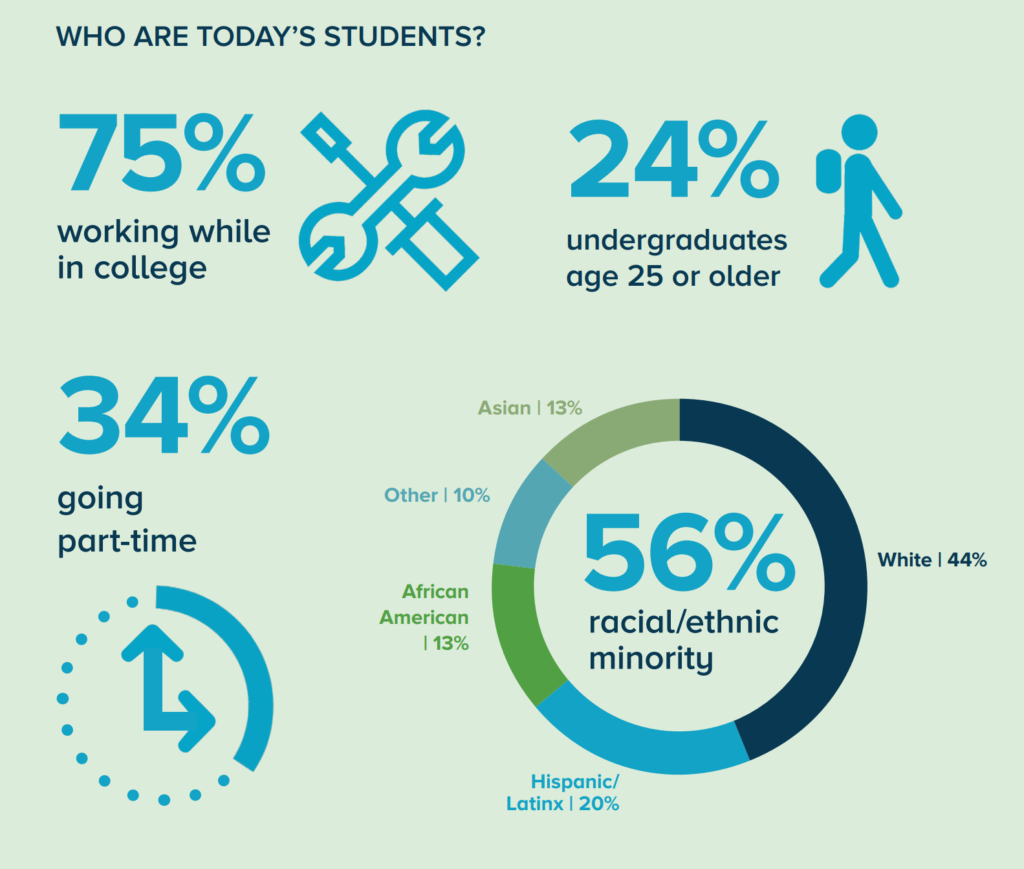New Jersey Governor Phil Murphy and Secretary of Higher Education Zakiya Smith Ellis unveiled “Where Opportunity Meets Innovation: A Student-Centered Vision for New Jersey Higher Education.” Central to the collaborative effort is a “Student Bill of Rights.” Murphy has created a task force to accomplish his outlined goals.
Creating the Plan
“Our goal is to keep more of young people here in New Jersey so they can become a part of this state’s future. I’m tired of New Jersey’s leading export being our college-bound high school seniors,” said Murphy as he announced the plan. Murphy also aims to ensure that recent higher education graduates have a place in the New Jersey economy.
Murphy and Smith Ellis emphasized that the plan is student-focused. “This is a student-driven plan, not an institution-driven plan. This is a plan created with direct engagement and listening to the needs of our students,” said Murphy.
“I am proud for the state to have this student-focused vision to chart the path forward,” Smith Ellis added.
The plan outlines a student bill of rights which details ten needs of students of higher education in New Jersey.
The plan was developed by the Office of the Secretary of Higher Education after meetings with educational stakeholders – such as students, faculty, and staff – analyzing relevant data, and reviewing past reports on Higher Education. The Office of the Secretary of Higher Education received over 10,000 responses – with half of those responses from students – in a survey they sent out last year to collect feedback.
“Stevens highlighted our excellent student outcomes, including the 96% placement rate; the 87% graduation rate (note that the national average for all colleges and universities is less than 60%); the excellent ROI of a Stevens education; as well as experiential learning programs such as co-op, undergraduate research, and capstone and senior design projects that help Stevens students do so well in the job market,” said Beth McGrath, Stevens’ Vice President for Government and Community Relations.

The Student Bill of Rights
According to the plan, “Every New Jerseyan, regardless of life circumstances, should have the opportunity to obtain a high-quality credential that prepares them for life after college.”
In order to accomplish this goal, the plan outlines a ten-point “Student Bill of Rights.”
First, the plan outlines that New Jersey students need early exposure to college. Specifically, they state that every student should be able to explore college and career options in secondary education, as well as have the ability to take college-level courses in high school.
The second point outlines that students need comprehensible financial information. Students should have clear information on how much college will cost them – including potential loan debt.
The Student Bill of Rights also calls for affordable and predictable education costs. The plan calls for colleges to be more affordable, including when taking into account non-tuition costs.
The fourth right calls for more experiential learning opportunities. The plan calls for students to have the ability to gain relevant experience in their fields outside the classroom.
Additionally, students need supportive staff and faculty. The plan notes a “tremendous” payoff when students build relationships with faculty and staff – including increasing their chance to graduate.
Students also needs support to complete college on-time. This includes reducing academic, social, and financial barriers that prevent completion.
The seventh right promotes students having the ability to gain college credit outside the classroom. This right aims to reward adults for relevant life experiences who are going back to school for a degree.
The next right calls to provide high-quality academic programs for students. These programs should align with student’s career and life goals.
The ninth point states that students need safe, supportive, and inclusive college campuses. This means that students feel safe from physical harm as well as feel welcome on campus.
The final point states that students should have a voice in decisions that affect their education. Student-centricity is at the core of the New Jersey Higher Education Plan.
“The State Plan’s ‘Student Bill of Rights’ enumerates a number of areas where Stevens is particularly strong—and where Stevens could serve as a model for other institutions,” said McGrath. “These include: providing early exposure to college (which we do through our growing Pre-College Summer programs); fostering student success, including experiential learning and supporting on-time graduation; and high quality academic programs, among others.”
Student-Centricity at its Core

The New Jersey State Higher Education Plan was developed with students in mind.
While developing the plan, Smith Ellis consulted with students at universities all across the state. “[I have] learned firsthand their passion for learning and the challenges they encounter on the way to getting a college credential,” said Smith Ellis. She noted that the plan is the result of her conversations with college students.
On November 15, 2018, President Nariman Farvardin sent an email to every student, faculty, and staff member: ‘Survey: Informing the State Plan for Higher Education.’ In the email, he emphasized that New Jersey’s Office of the Secretary of Higher Education wanted to hear direct feedback from current students.
Additionally, within the Student Bill of Rights, the last “right” listed calls for students to have a voice in the decision-making process for topics that affect their education. “The diverse perspectives of New Jersey’s college students can provide new approaches and add innovative solutions to improve higher education within the state,” the plan stated.
Students just having a seat at the table is not enough. Even though Student Government Representatives may have a seat at the decision making table, others at the table need to value their voice. Nationally, only two-thirds of Student Government Presidents felt they had a voice in their school’s decision making.
According to Jason Chlus, President of the Student Government Association (SGA), Stevens is one of those schools: “One of the initiatives that my VPAA [Alex Reina] and I are working are restructuring the engineering curriculum to make it more applicable to students. So in regards to having a voice for education I would say yes.”
“I think it’s probably the most important that students should be actively participating and have a seat at every table in which decisions are made that impact their education,” said Smith Ellis. Smith Ellis emphasized that this applies to all decisions – whether its locally on the Board of Trustees or on state-wide initiatives.
Currently, there is not a student representative to the Board of Trustees at Stevens. “My role with the board of trustees is fairly small. I have had conversations with Matt [Hunt] and Olivia [Schreiber] and there was not a lot that they could tell me what they were working on,” said Chlus. Hunt and Schreiber are Young Alumni members on the Stevens Board of Trustees.
The plan includes establishing working groups to complete the goals outlined in the Student Bill of Rights. Students will be a member of each working group. “We want all students to apply to be members of our working groups because we really feel like there’s not enough student input,” said Smith Ellis. “We wanted it to be a plan that is student-focused.” She noted that the focus should be what students need, not what colleges need.
Currently, students from the Government and Community Relations Committee of the Student Government Association have been lobbying the New Jersey State Legislature to pass a bill that will “establish [a] New Jersey Higher Education Student Advisory Committee.” The bill has been introduced in the Senate as S2965 and in the Assembly as A5207.
Smith Ellis, when asked for comment on the legislation, said, “I can tell you that the plan says that we want students to have a seat at every table.”
Putting the Plan to Action
In order to accomplish the goals, Murphy signed Executive Order No. 61. This order created a task force divided into five working groups to accomplish the goals outlined in the plan. The five working groups include: creating on-ramps to college; making college affordable; student success; safe and inclusive learning environments; and research, innovation, and talent. The task force will contain at least 10 members, including at least two student members.
“It is likely that a Stevens representative will serve on at least one of the committees,” said McGrath.
Each one of the five working groups will aim to translate at least one of the goals in the Student Bill of Rights into workable action items. Listed in the plan are specific tasks for each group to accomplish.
The first group, creating on-ramps for colleges, aims to increase early exposure to college. The group will be tasked with exploring why students choose to attend a school outside of New Jersey and creating a fee-free model for dual enrollment and other programs.
The next group, making college affordable, aims to accomplish the second and third item on the bill of rights: students should have clear and comprehensible financial information as well as affordable and predictable education costs. The group will be charged with creating a guide on non-tuition costs for students, creating an affordability benchmark, and proposing a completion-orientated funding model.
The working group on fostering student success aims to ensure students can complete college on-time and have the opportunity to earn credit outside the classroom. The group has four tasks: exploring alternatives to developmental education, exploring how to standardize college credit, investigating multi-intervention models, and identifying strategies to accelerate degree progress.
The group on promoting safe and inclusive learning environments aims to ensure students have a voice in their education and are learning on safe, supportive, and inclusive campuses. The group will promote data analysis through a campus climate survey, establish best practices for creating a safe and inclusive environment on campuses, and draft a guide for implementing the recommendations from the 2017 Task Force on Campus Sexual Assault.
The final working group, cultivating research, innovation, and talent, will aim to accomplish three items on the Student Bill of Rights: experiential learning opportunities, supportive faculty and staff, and high-quality academic programs. This group will aim to increase women and underrepresented minorities in STEM, determine how to attract diverse faculty and staff, develop partnerships to ensure research and employment for students, and identify strategies to increase research, development, and commercial activities at state-sponsored research universities.
While universities are not required to take part in the plan unless they wish to receive state funding, Smith Ellis believes that universities will want to buy into the plan as it was developed with feedback from colleges. “We feel that every single college in state should be able to state ‘Yes I commit in principle, there’s nothing here that I’m not going to work with the state to accomplish,’” said Smith Ellis. Smith Ellis added they will ask universities for a formal commitment to the plan.
“We will monitor the discussions and recommendations of the working groups in the coming months to better understand the implications of the State’s Plan for Higher Education and its impact on Stevens,” said McGrath.
The findings of the working groups will be public and are due within one year of the announcement of the higher education plan.

Be First to Comment